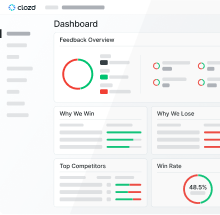
Win Rate 101
Win Rate. You know the number. Or, maybe you don’t. What exactly does it mean? Are there more ways than one to calculate it? How can it impact your business? To understand how win rate affects critical business strategy, first we need to understand the what and why of win rate.
So, let’s get started with some basic definitions.
What is a closed opportunity?
You may have heard salespeople brag about “closing” deals, but the term closed opportunity actually refers to any deal that comes to an end - won or lost. So, next time you hear a salesperson brag about how they “closed” a deal, give them a hard time by asking whether they won or lost. As a side note, this definition also sheds some light on why we named our company “Clozd.”
Win Rate by Number of Deals Closed
Win rate by count is the ratio of deals won to the number of total closed opportunities. Thus, win rate by count answers the question, “how often do I win?” For instance, if you had 8 closed deals in the past month and only 2 of those were wins then your win rate by count is 25% (2/8=0.25).
Win Rate by Amount
How you measure win rate matters. What we defined above is win rate by count — we counted the deals won and the deals lost. Another effective measure of win rate is by amount, or monetary value. This could be MRR, ARR, or whatever monetary value you assign to each deal. For example, looking at the same example above, let’s say that each of the 2 deals you won were worth $40,000 and the sum total of all 8 deals is $140,000. Your win rate by amount is $80,000/$140,000, or 57.1%. Wait . . . what? First it was 25%, and now it’s 57.1%?
Why are these win rates different?
It’s because win rate by amount is answering a slightly different question. It’s asking “What percent of the cash in my pipeline am I winning?” In our example above, your 2 wins must have been two of the larger deals in your pipeline.
Which measure is better?
Both. You want both measures to provide a balanced view of your win rate.
For example, you could use win rate by count to estimate the number of opportunities (deals) your sales team needs to add to pipeline in order to achieve next quarter’s quota. Just divide next quarter’s quota by your average deal size. This gives you the approximate number of opportunities that the team needs to win. Then, use win rate by count to zoom out and determine how many total sales opportunities need to be added to pipeline in order to achieve the goal.
In contrast, win rate by amount can shed light on the size(s) of deals that your team, or a particular salesperson, excels at winning. You may notice that they have a tendency to win more deals that are over or under a certain dollar amount.
Ultimately, I recommend calculating both and comparing them side-by-side.

How to Maximize your Win Rate Analysis
Context is everything. By itself, win rates only give you a glimpse into what’s happening. Applying additional context to your analysis will help you derive richer insights and take action.
For example, you know that your win rate is 25%. Is that good or bad? Are salespeople logging legitimate opportunities? What can you do to improve your win rate? How did it get that way? Win rates by count or amount can’t answer these questions on their own.
If you start to apply context to your win rates, you’ll derive richer insights.
Here are some examples:
- Apply time to your analysis. If you monitor win rates over time (i.e. by quarter) you will begin to notice trends. You may observe that win rates are steadily improving.
- Apply geography to your analysis. If you break win rates down by sales region or territory then you may notice trends, like certain regions outperforming others.
- Apply customer segmentation to your analysis. If you break win rates down by customer segment then you may notice additional trends, like higher success rates selling into certain verticals or industries.
- Add a competitor dimension to your analysis. If you track the competitors that are in play for each opportunity then you can analyze competitive trends. Compare win rates by competitor to w which competitors are the hardest and easiest to beat.

With the help of context, the picture will start to become more clear and the insights will become more actionable. Try leading with a question you want answered. How does X affect win rate? How does Y change when dissected by X?
Other dimensions to consider in your analysis include:
- Lead Source
- Product
- Opportunity Type (new, upgrade, renewal, etc.)
- Pipeline Stage
- Any other relevant account or opportunity field from your CRM.
How can win rates help my business?
By now, you understand the basics of win rate analysis. You might wonder, “What do I do with this?” The ultimate goal of win-rate analysis is to find ways to improve your win rate over time. Three specific strategies to consider, that will help you translate your analysis into business outcomes include:
- Fix the bad. Win rate analysis can identify areas of improvement in your product or your organization. Use it to eliminate problems. For example, if you notice that your win rate with a certain product dips in Q4 every year, you can decrease marketing or sales efforts in that product (if it makes sense to your business).
- Perfect the good. On the flip side, win rate analysis also points out those factors that help you win. This analysis gives you a chance to lean in. For example, if you have a sales rep that has a higher win rate in EMEA than the rest of your team, you can have him or her handle the EMEA deals.
- Qualify leads. While leads are not inherently negative, having leads that don’t convert to sales are expensive. Win rate analysis will reveal attributes of your target market -- those who actually buy from you. By knowing when a lead is not likely to purchase your product or service, you can stop selling sooner and focus on those with a higher rate of conversion.
The Next Step
Understanding win rates is a foundational piece of win-loss analysis. But, ultimately, win rates only tell a part of the story. They tell you what is happening, but not necessarily why. To truly understand why you win and lose, you need direct feedback from decision-makers at won and lost accounts. You need to hear from them why they made their final decision.
Clozd can help you implement an ongoing win-loss feedback program that centers on feedback from those decision-makers. We are the win-loss experts and our mission is to help you figure out why you win and lose, so you can start winning more.











.svg)



.png)






.svg)

.svg)




